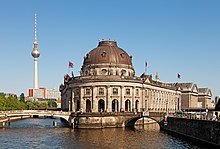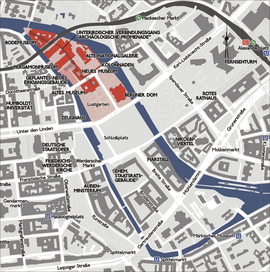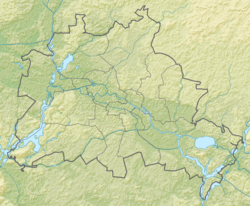| UNESCO World Heritage Site | |
|---|---|
 The Bode-Museum on Museum Island | |
| Location | Berlin, Germany |
| Criteria | Cultural: ii, iv |
| Reference | 896 |
| Inscription | 1999 (23rd Session) |
| Area | 8.6 ha (21 acres) |
| Buffer zone | 22.5 ha (56 acres) |
| Coordinates | 52°31′17″N 13°23′44″E / 52.52139°N 13.39556°E |
 Location of Museum Island (in red) on Spree Island | |
The Museum Island (German: Museumsinsel) is a museum complex on the northern part of Spree Island in the historic heart of Berlin, Germany. It is one of the capital's most visited sights and one of the most important museum sites in Europe. Originally built from 1830 to 1930, initially by order of the Prussian Kings, according to plans by five architects, the Museum Island was designated a UNESCO World Heritage Site in 1999 because of its testimony to the architectural and cultural development of museums in the 19th and 20th centuries. It consists of the Altes Museum, the Neues Museum, the Alte Nationalgalerie, the Bode-Museum and the Pergamonmuseum.[1] As the Museum Island designation includes all of Spree Island north of the Karl Liebknecht Boulevard, the historic Berlin Cathedral is also located there, next to the open Lustgarten park. To the south of Liebknecht Boulevard, the reconstructed Berlin Palace houses the Humboldt Forum museum and opened in 2020. Also adjacent, across the west branch of the Spree is the German Historical Museum. Since German reunification, the Museum Island has been rebuilt and extended according to a master plan.[2] In 2019, a new visitor center and art gallery, the James Simon Gallery (by a sixth architect), was opened within the Museum Island heritage site.
- ^ "Museumsinsel (Museum Island), Berlin". UNESCO World Heritage Centre. United Nations Educational Scientific and Cultural Organization. Archived from the original on 6 May 2021. Retrieved 20 July 2022.
- ^ "Masterplan Museumsinsel". Archived from the original on 4 February 2023. Retrieved 11 July 2020.

